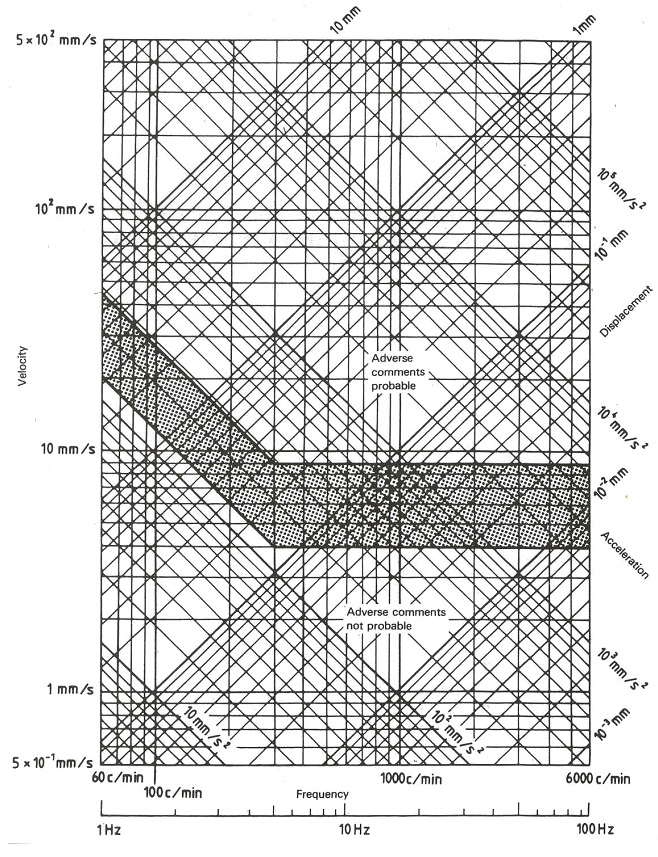7.2.1 Section 6 of LR’s Ship Vibration and Noise Guidance Notes cover this subject. Human
tolerance of vibration is essentially subjective, and perceptions vary between
individuals. However, the ISO produced criteria ISO 6954 in 1984. These are based
upon single amplitude peak responses at a discrete frequency, that is, for narrow
frequency band or single order. Vibration levels in the form of displacement,
velocity and acceleration are presented in the acceptance chart, which are of course
interrelated by simple harmonic motion. Vibration velocity in millimetres per second
(mm/s) is usually chosen as the preferred parameter for assessment.
7.2.2 With reference to Figure 3, the acceptance chart shown on the next page, frequency is
measured on the horizontal axis and vibration velocity is measured on the vertical
access, and it essentially features three zones. These reflect the subjective nature
of vibration acceptability: ‘adverse comments probable’, ‘adverse comments not
probable’, and a transition zone between these. Above a frequency of 5 Hz, the
vibration response level at the top of the transition zone is 9 mm/s and at the
bottom is 4 mm/s. Below 5 Hz, a linear increase in acceptable vibration velocities
is indicated, which is consistent with the generally increased human tolerance
relating to lower frequencies.
7.2.3 In the past for frequencies above 5 Hz, 9 mm/s was often viewed as an acceptable
vibration level for habitable areas of cargo ships. More recently, in connection
with improved standards of crew accommodation, 4 mm/s is usually stated as the
contractual requirement for cargo ships in relation to ISO 6954 (1984). Contractual
requirements for passenger ships are, of course, invariably much more demanding: in
accommodation areas, a criterion of 2 mm/s is typical; and this is even as low as 1
mm/s for some mega yachts. As previously mentioned, vibration criteria are designed
for application to measurements, which are made on ship trials or in service. The
ISO 6954 (1984) standard recognises that peak responses in relation to measurements
would not be expected to be in accordance with a perfect sinusoidal curve, as in a
vibration prediction analysis, and it uses the description ‘maximum repetitive
value’ instead. In practice, this is somewhat open to interpretation, and it has
often led to a difference of opinion about the maximum repetitive value in a time
series of measurements.
7.2.4 Mainly to resolve the issue of quantifying maximum repetitive value in relation to
measurements, ISO 6954 (2000) was developed. This is based upon a weighted root mean
square average vibration response for all frequencies in the range 1 - 80 Hz, that
is, for broad frequency band or sum of all orders. Using appropriate measurement
equipment then gives a single value for comparison with criteria, which makes the
assessment of measurements easier and not open to interpretation.
7.2.5 Although an algorithm to adapt and combine predicted vibration responses may be
applied for comparison with ISO 6954 (2000) criteria, this standard tends to be less
well suited and informative in relation to vibration prediction analysis.
Consequently, LR usually assesses predicted vibration responses on the basis of ISO
6954 (1984) as appropriate, which enables review of the response to each vibration
excitation order separately.

Figure 1.7.1 Accommodation and workplace vibration levels